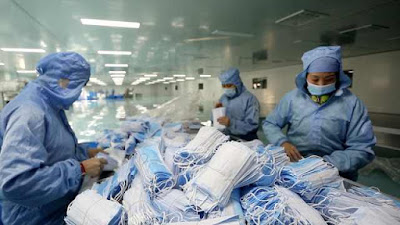IN 2010, the Chinese government's five-year economic plan ordered a ''focus on developing basic equipment and medical materials that have high demand, wide application and are mainly imported.''
Alarmed at China's stranglehold over supplies of masks, gowns, test kits and other front-line weapons for battling the coronavirus, countries around the world have set up their own factories to cope with the pandemic and outbreaks of the future.
But when the outbreak subsides, those factories may struggle to survive. China has laid the groundwork to dominate the market for protective and medical supplies for years to come.
Factory owners get cheap land, courtesy of the Chinese government. Loans and subsidies are plentiful. Chinese hospitals are often told to buy locally, giving Chinese suppliers a vast and captive market.
Once vaccines emerge, demands will plummet. Factories will close. But Chinese companies are likely to have the lowest costs by far and be best positioned for the next global outbreak.
''The Chinese have been successfully weaving global personal protection equipment dominance with supply chain command and control,'' said Omar Allam, a former Canadian trade official trying to establish production of in-demand N95 medical respirators in his country.
China's grip on the market is a testament to its drive to dominate important cogs in the global industrial machine.
For years, the Chinese leaders have worried that the country depended too much on foreign sources for necessities as varied as medical supplies, microchips and airliners.
It has used subsidies, economic targets and other government inducements to emerge as a powerhouse in those important industries.
When Chinese leaders grew concerned about pollution and dependence on foreign oil, for example, they helped local makers of solar panels, wind turbines and high-speed rail equipment clobber the competition.
They have taken similar steps to dominate industries of the future, like the next generation of wireless data transmission, known as 5G.
The state's heavy involvement in its economy has led to waste and graft that could slow China's growth. But the policies have often proved effective in building industries that can withstand losses and tough foreign-competition. The outcome on medical supplies may be similar.
''There will be massive consolidation after the epidemic,'' said Howrd Yu, a professor of management and innovation at the Institute for Management Development, a business school in Switzerland.
''It will be exactly the same dynamics as in green energy, 5G and high speed rail.''
Before the pandemic, China already exported more respirators, surgical masks, medical goggles and protective garments than the rest of the world combined, the Peterson institute for International Economics estimated.
Beijing's coronavirus response has only added to that dominance. It increased mask productions nearly 12-fold in February alone.
It can now make 150 tons per day of the specialized fabric used for masks, said Bob McIIvane, who runs a namesake research and consulting firm in Northfield, ILL.
That is five times what China could make before the outbreak, and 15 times the output of U.S. companies, even after they increased production this spring.
The Honor and serving of the Latest Global Operational Research on Global Manufacturing and Chinese Economics, continues. The World Students Society thanks author Keith Bradsher.

.png)


0 comments:
Post a Comment
Grace A Comment!